Literature Review on Nurse Fatigue and Stress in Healthcare Settings
VerifiedAdded on 2023/06/07
|9
|2336
|234
Literature Review
AI Summary
This literature review explores the critical issue of nurse fatigue and stress within healthcare settings. It examines the causes, including long working hours, shift patterns, and the demanding nature of patient care. The review synthesizes research on the impact of fatigue on patient safety and nurse well-being, highlighting the importance of hospital administration's recognition of the problem. Strategies discussed include reducing work hours, promoting flexible shift timings, and providing adequate rest. The review also identifies gaps in the existing literature, such as the role of nutrition in mitigating fatigue. The assignment emphasizes the need for comprehensive solutions involving nurses, hospital staff, and administration to ensure quality care and patient safety. The review focuses on the need for adequate rest and relaxation for nurses to combat fatigue and burnout, proposing strategies such as reducing shift timings and providing more breaks.
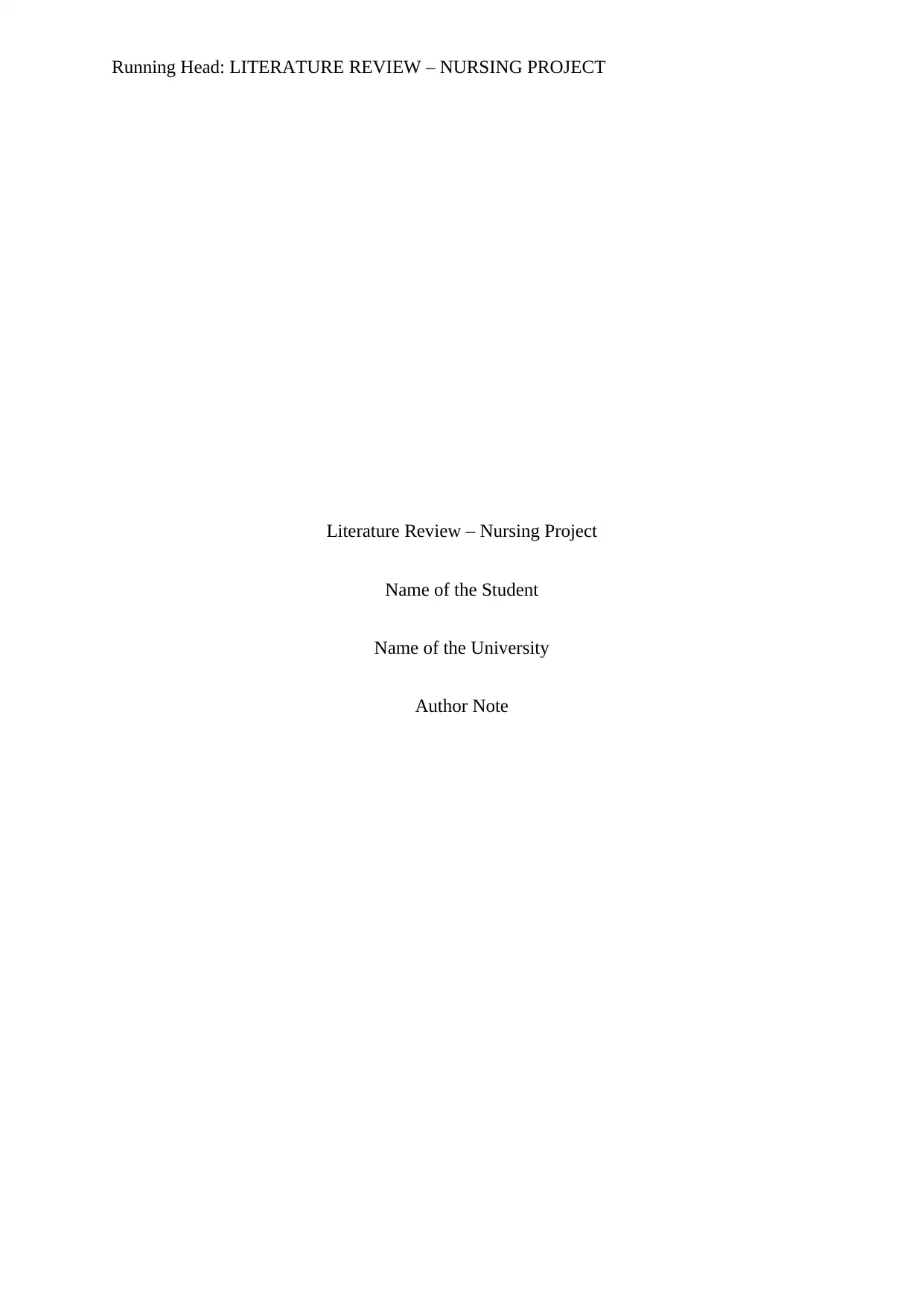
Running Head: LITERATURE REVIEW – NURSING PROJECT
Literature Review – Nursing Project
Name of the Student
Name of the University
Author Note
Literature Review – Nursing Project
Name of the Student
Name of the University
Author Note
Secure Best Marks with AI Grader
Need help grading? Try our AI Grader for instant feedback on your assignments.
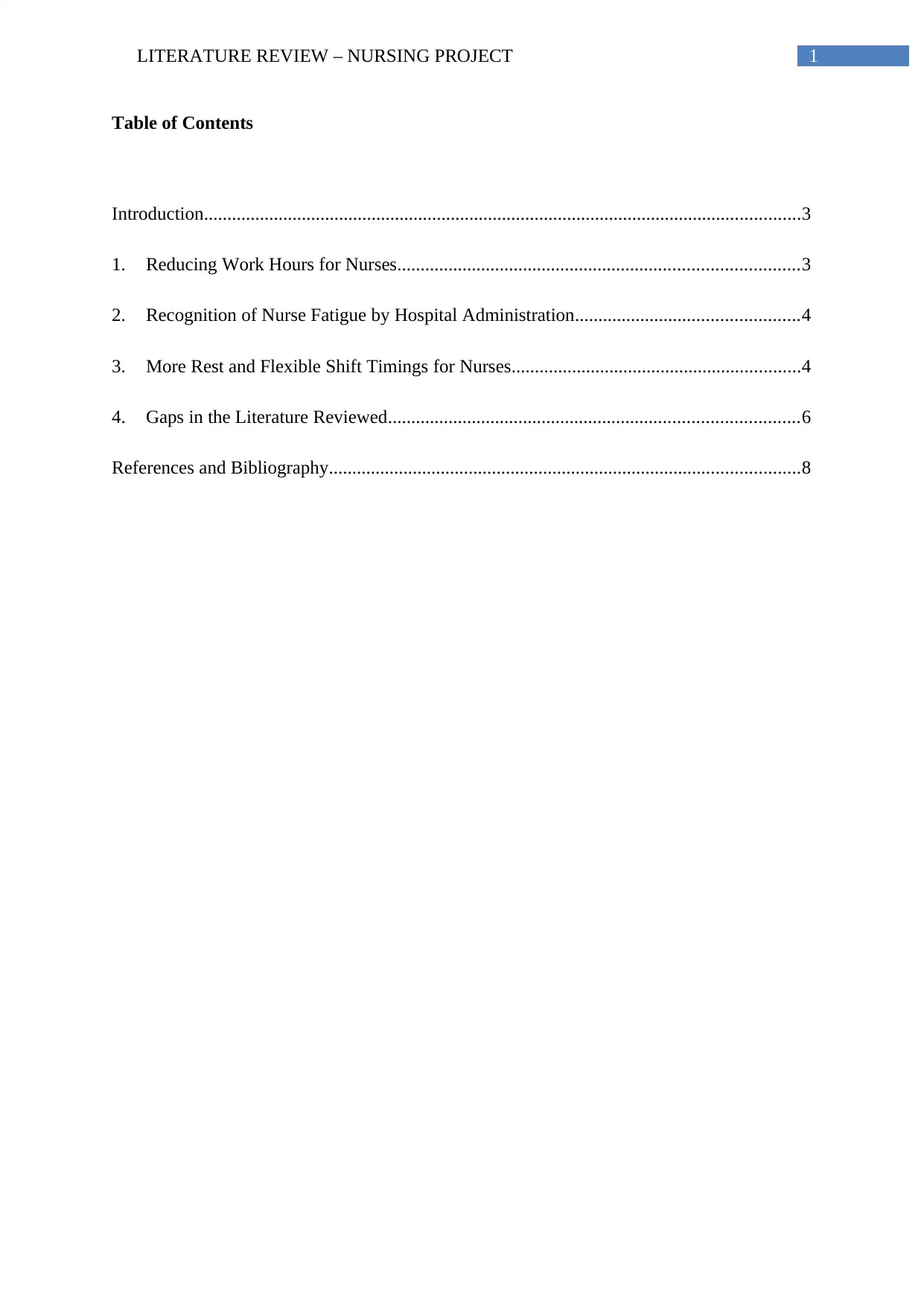
1LITERATURE REVIEW – NURSING PROJECT
Table of Contents
Introduction................................................................................................................................3
1. Reducing Work Hours for Nurses......................................................................................3
2. Recognition of Nurse Fatigue by Hospital Administration................................................4
3. More Rest and Flexible Shift Timings for Nurses..............................................................4
4. Gaps in the Literature Reviewed........................................................................................6
References and Bibliography.....................................................................................................8
Table of Contents
Introduction................................................................................................................................3
1. Reducing Work Hours for Nurses......................................................................................3
2. Recognition of Nurse Fatigue by Hospital Administration................................................4
3. More Rest and Flexible Shift Timings for Nurses..............................................................4
4. Gaps in the Literature Reviewed........................................................................................6
References and Bibliography.....................................................................................................8

2LITERATURE REVIEW – NURSING PROJECT
Introduction
Nurses form a valuable and integral part of every hospital or medical clinic. Nurses
work for long hours in the day and attend to patients who are admitted in the hospital, for
treatment or surgery. Nurses also assist doctors and surgeons with the work that they do and
are seldom known to take a break in between their tasks, demonstrating great dedication and
efficiency in the work that they do. They move from one task to another in an almost
effortless fashion. As a result, the problem of stress and fatigue for nurses, both male as well
as female, is one that tends to be quite high. Almost all the nurses working in Australia are
known to suffer fatigue in some form or the other. This essay undertakes a literature review
on the issue of nurse stress and fatigue in hospitals and nursing homes, with the aim of the
review being to uncover strategies to combat the problem of nurse fatigue and stress in the
best way possible.
1. Reducing Work Hours for Nurses
Peter Griffiths and others (2014), have raised the concern of nurse fatigue and high
stress levels in their recent research on the subject. They argue that nurses who are made to
work for a shift that is longer than twelve hours are more likely to report problems like
patient safety failure than nurses who are made to work for less than twelve hours. According
to them, most hospitals today opt for the twelve to thirteen hour shift timing in order to avoid
the confusion that occurs at the time of shift handover from one nurse to another. Nurses are
also made to work twelve hour shifts in order to help hospitals and medical setups cut down
on costs on the pay of healthcare professionals. This in turn has an adverse effect on their
health and they end up feeling highly stressed and failing in their duties, the primary one
being patient care and safety so only by making them work for under twelve hours can be the
Introduction
Nurses form a valuable and integral part of every hospital or medical clinic. Nurses
work for long hours in the day and attend to patients who are admitted in the hospital, for
treatment or surgery. Nurses also assist doctors and surgeons with the work that they do and
are seldom known to take a break in between their tasks, demonstrating great dedication and
efficiency in the work that they do. They move from one task to another in an almost
effortless fashion. As a result, the problem of stress and fatigue for nurses, both male as well
as female, is one that tends to be quite high. Almost all the nurses working in Australia are
known to suffer fatigue in some form or the other. This essay undertakes a literature review
on the issue of nurse stress and fatigue in hospitals and nursing homes, with the aim of the
review being to uncover strategies to combat the problem of nurse fatigue and stress in the
best way possible.
1. Reducing Work Hours for Nurses
Peter Griffiths and others (2014), have raised the concern of nurse fatigue and high
stress levels in their recent research on the subject. They argue that nurses who are made to
work for a shift that is longer than twelve hours are more likely to report problems like
patient safety failure than nurses who are made to work for less than twelve hours. According
to them, most hospitals today opt for the twelve to thirteen hour shift timing in order to avoid
the confusion that occurs at the time of shift handover from one nurse to another. Nurses are
also made to work twelve hour shifts in order to help hospitals and medical setups cut down
on costs on the pay of healthcare professionals. This in turn has an adverse effect on their
health and they end up feeling highly stressed and failing in their duties, the primary one
being patient care and safety so only by making them work for under twelve hours can be the
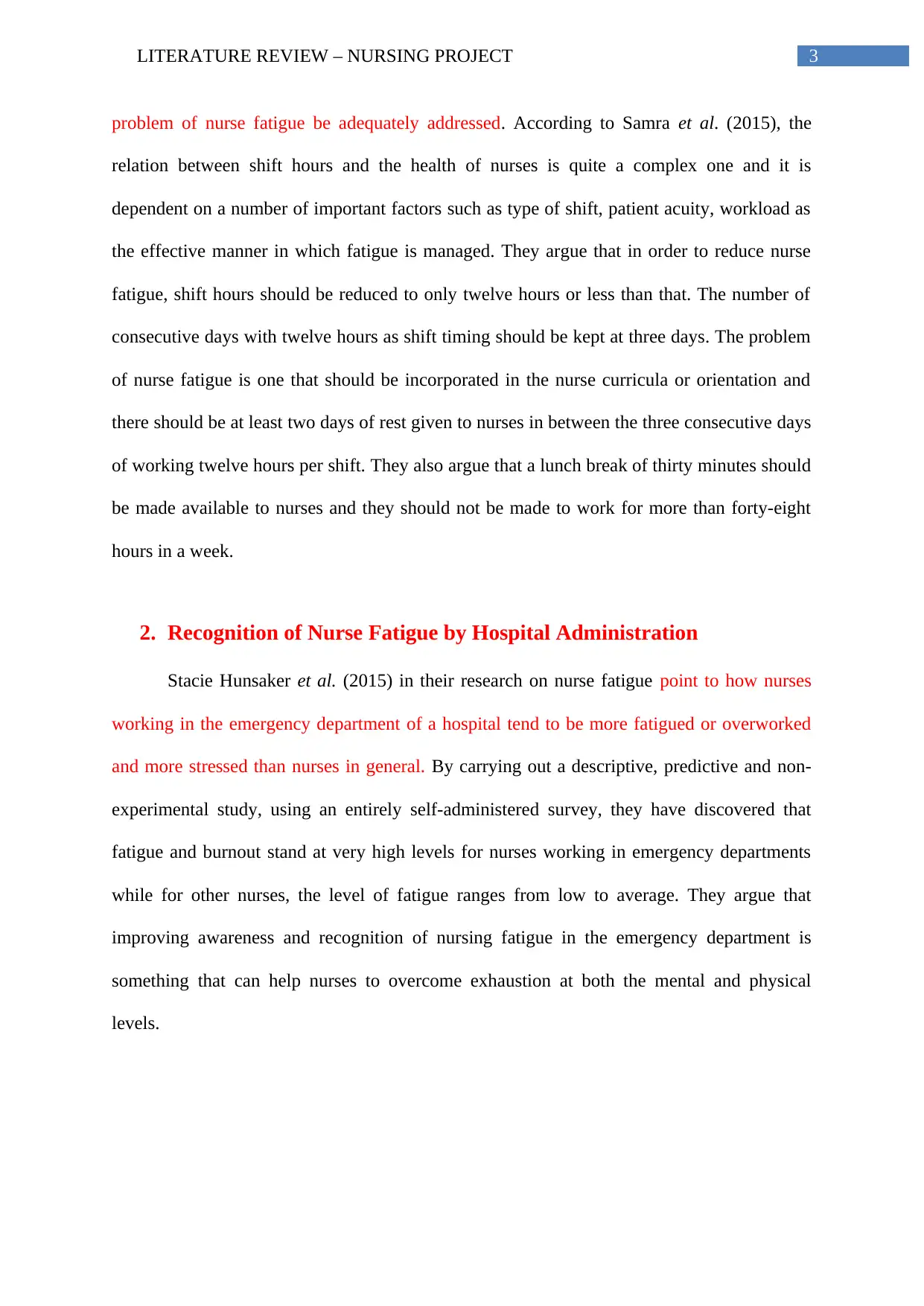
3LITERATURE REVIEW – NURSING PROJECT
problem of nurse fatigue be adequately addressed. According to Samra et al. (2015), the
relation between shift hours and the health of nurses is quite a complex one and it is
dependent on a number of important factors such as type of shift, patient acuity, workload as
the effective manner in which fatigue is managed. They argue that in order to reduce nurse
fatigue, shift hours should be reduced to only twelve hours or less than that. The number of
consecutive days with twelve hours as shift timing should be kept at three days. The problem
of nurse fatigue is one that should be incorporated in the nurse curricula or orientation and
there should be at least two days of rest given to nurses in between the three consecutive days
of working twelve hours per shift. They also argue that a lunch break of thirty minutes should
be made available to nurses and they should not be made to work for more than forty-eight
hours in a week.
2. Recognition of Nurse Fatigue by Hospital Administration
Stacie Hunsaker et al. (2015) in their research on nurse fatigue point to how nurses
working in the emergency department of a hospital tend to be more fatigued or overworked
and more stressed than nurses in general. By carrying out a descriptive, predictive and non-
experimental study, using an entirely self-administered survey, they have discovered that
fatigue and burnout stand at very high levels for nurses working in emergency departments
while for other nurses, the level of fatigue ranges from low to average. They argue that
improving awareness and recognition of nursing fatigue in the emergency department is
something that can help nurses to overcome exhaustion at both the mental and physical
levels.
problem of nurse fatigue be adequately addressed. According to Samra et al. (2015), the
relation between shift hours and the health of nurses is quite a complex one and it is
dependent on a number of important factors such as type of shift, patient acuity, workload as
the effective manner in which fatigue is managed. They argue that in order to reduce nurse
fatigue, shift hours should be reduced to only twelve hours or less than that. The number of
consecutive days with twelve hours as shift timing should be kept at three days. The problem
of nurse fatigue is one that should be incorporated in the nurse curricula or orientation and
there should be at least two days of rest given to nurses in between the three consecutive days
of working twelve hours per shift. They also argue that a lunch break of thirty minutes should
be made available to nurses and they should not be made to work for more than forty-eight
hours in a week.
2. Recognition of Nurse Fatigue by Hospital Administration
Stacie Hunsaker et al. (2015) in their research on nurse fatigue point to how nurses
working in the emergency department of a hospital tend to be more fatigued or overworked
and more stressed than nurses in general. By carrying out a descriptive, predictive and non-
experimental study, using an entirely self-administered survey, they have discovered that
fatigue and burnout stand at very high levels for nurses working in emergency departments
while for other nurses, the level of fatigue ranges from low to average. They argue that
improving awareness and recognition of nursing fatigue in the emergency department is
something that can help nurses to overcome exhaustion at both the mental and physical
levels.
Secure Best Marks with AI Grader
Need help grading? Try our AI Grader for instant feedback on your assignments.
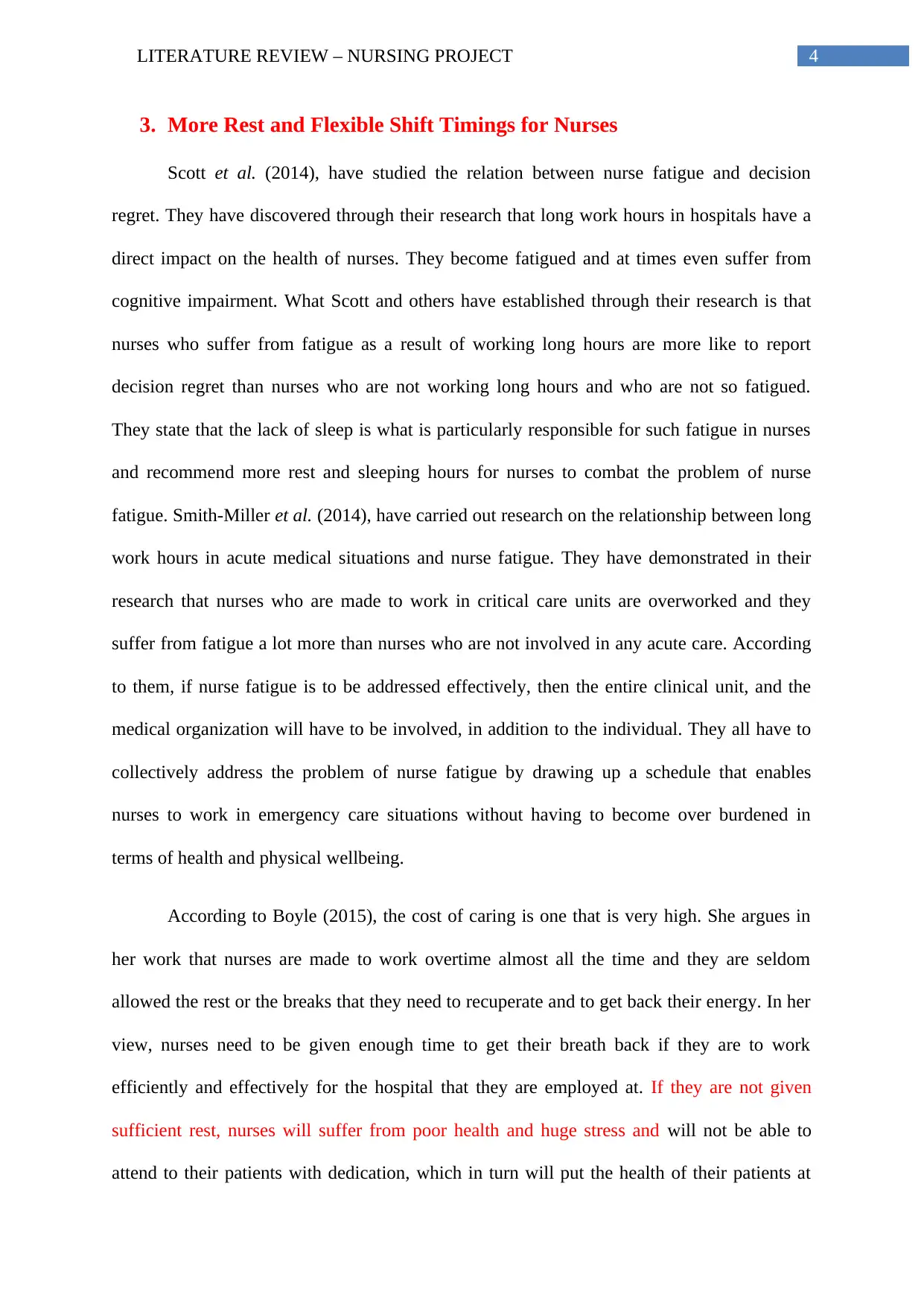
4LITERATURE REVIEW – NURSING PROJECT
3. More Rest and Flexible Shift Timings for Nurses
Scott et al. (2014), have studied the relation between nurse fatigue and decision
regret. They have discovered through their research that long work hours in hospitals have a
direct impact on the health of nurses. They become fatigued and at times even suffer from
cognitive impairment. What Scott and others have established through their research is that
nurses who suffer from fatigue as a result of working long hours are more like to report
decision regret than nurses who are not working long hours and who are not so fatigued.
They state that the lack of sleep is what is particularly responsible for such fatigue in nurses
and recommend more rest and sleeping hours for nurses to combat the problem of nurse
fatigue. Smith-Miller et al. (2014), have carried out research on the relationship between long
work hours in acute medical situations and nurse fatigue. They have demonstrated in their
research that nurses who are made to work in critical care units are overworked and they
suffer from fatigue a lot more than nurses who are not involved in any acute care. According
to them, if nurse fatigue is to be addressed effectively, then the entire clinical unit, and the
medical organization will have to be involved, in addition to the individual. They all have to
collectively address the problem of nurse fatigue by drawing up a schedule that enables
nurses to work in emergency care situations without having to become over burdened in
terms of health and physical wellbeing.
According to Boyle (2015), the cost of caring is one that is very high. She argues in
her work that nurses are made to work overtime almost all the time and they are seldom
allowed the rest or the breaks that they need to recuperate and to get back their energy. In her
view, nurses need to be given enough time to get their breath back if they are to work
efficiently and effectively for the hospital that they are employed at. If they are not given
sufficient rest, nurses will suffer from poor health and huge stress and will not be able to
attend to their patients with dedication, which in turn will put the health of their patients at
3. More Rest and Flexible Shift Timings for Nurses
Scott et al. (2014), have studied the relation between nurse fatigue and decision
regret. They have discovered through their research that long work hours in hospitals have a
direct impact on the health of nurses. They become fatigued and at times even suffer from
cognitive impairment. What Scott and others have established through their research is that
nurses who suffer from fatigue as a result of working long hours are more like to report
decision regret than nurses who are not working long hours and who are not so fatigued.
They state that the lack of sleep is what is particularly responsible for such fatigue in nurses
and recommend more rest and sleeping hours for nurses to combat the problem of nurse
fatigue. Smith-Miller et al. (2014), have carried out research on the relationship between long
work hours in acute medical situations and nurse fatigue. They have demonstrated in their
research that nurses who are made to work in critical care units are overworked and they
suffer from fatigue a lot more than nurses who are not involved in any acute care. According
to them, if nurse fatigue is to be addressed effectively, then the entire clinical unit, and the
medical organization will have to be involved, in addition to the individual. They all have to
collectively address the problem of nurse fatigue by drawing up a schedule that enables
nurses to work in emergency care situations without having to become over burdened in
terms of health and physical wellbeing.
According to Boyle (2015), the cost of caring is one that is very high. She argues in
her work that nurses are made to work overtime almost all the time and they are seldom
allowed the rest or the breaks that they need to recuperate and to get back their energy. In her
view, nurses need to be given enough time to get their breath back if they are to work
efficiently and effectively for the hospital that they are employed at. If they are not given
sufficient rest, nurses will suffer from poor health and huge stress and will not be able to
attend to their patients with dedication, which in turn will put the health of their patients at
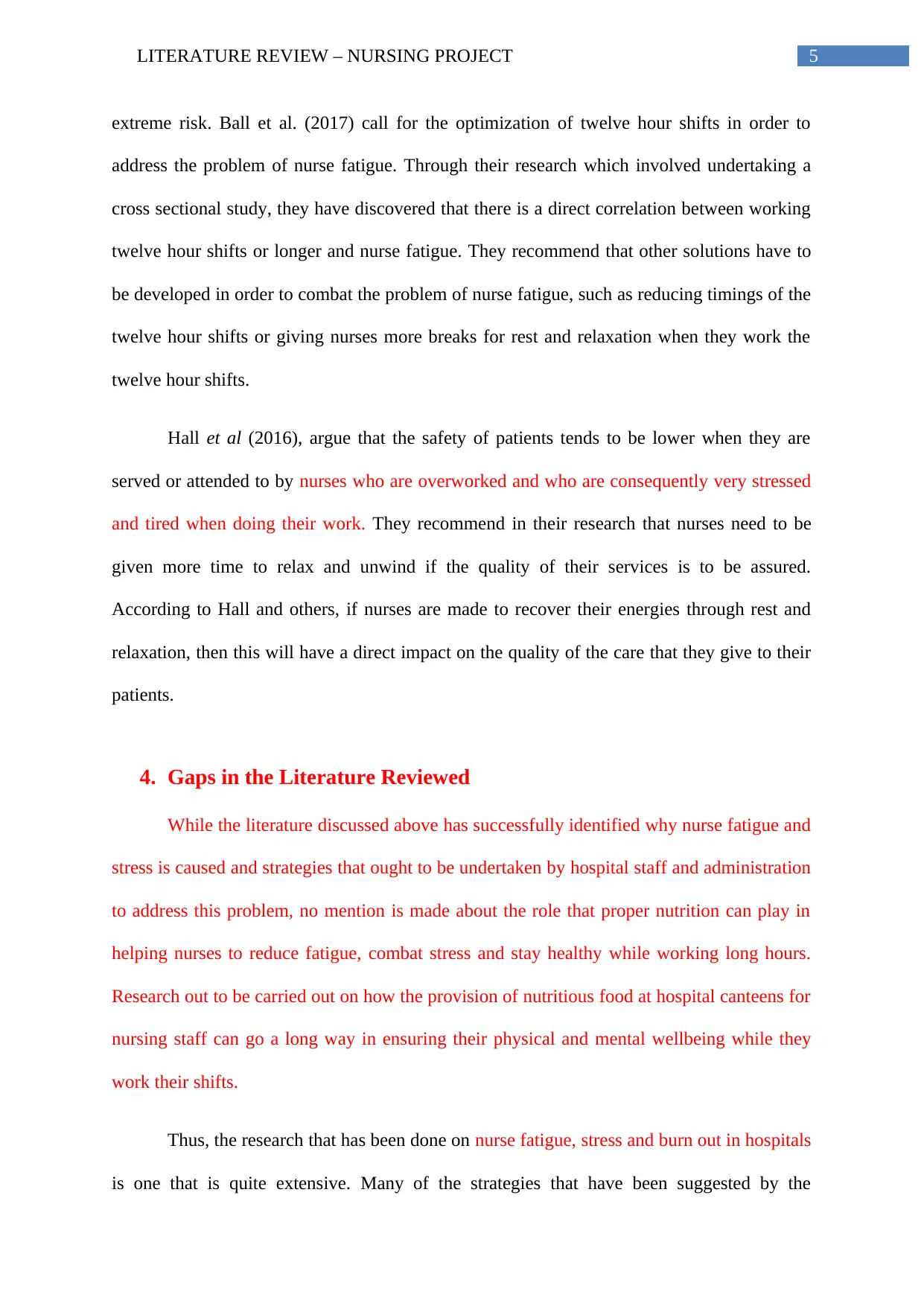
5LITERATURE REVIEW – NURSING PROJECT
extreme risk. Ball et al. (2017) call for the optimization of twelve hour shifts in order to
address the problem of nurse fatigue. Through their research which involved undertaking a
cross sectional study, they have discovered that there is a direct correlation between working
twelve hour shifts or longer and nurse fatigue. They recommend that other solutions have to
be developed in order to combat the problem of nurse fatigue, such as reducing timings of the
twelve hour shifts or giving nurses more breaks for rest and relaxation when they work the
twelve hour shifts.
Hall et al (2016), argue that the safety of patients tends to be lower when they are
served or attended to by nurses who are overworked and who are consequently very stressed
and tired when doing their work. They recommend in their research that nurses need to be
given more time to relax and unwind if the quality of their services is to be assured.
According to Hall and others, if nurses are made to recover their energies through rest and
relaxation, then this will have a direct impact on the quality of the care that they give to their
patients.
4. Gaps in the Literature Reviewed
While the literature discussed above has successfully identified why nurse fatigue and
stress is caused and strategies that ought to be undertaken by hospital staff and administration
to address this problem, no mention is made about the role that proper nutrition can play in
helping nurses to reduce fatigue, combat stress and stay healthy while working long hours.
Research out to be carried out on how the provision of nutritious food at hospital canteens for
nursing staff can go a long way in ensuring their physical and mental wellbeing while they
work their shifts.
Thus, the research that has been done on nurse fatigue, stress and burn out in hospitals
is one that is quite extensive. Many of the strategies that have been suggested by the
extreme risk. Ball et al. (2017) call for the optimization of twelve hour shifts in order to
address the problem of nurse fatigue. Through their research which involved undertaking a
cross sectional study, they have discovered that there is a direct correlation between working
twelve hour shifts or longer and nurse fatigue. They recommend that other solutions have to
be developed in order to combat the problem of nurse fatigue, such as reducing timings of the
twelve hour shifts or giving nurses more breaks for rest and relaxation when they work the
twelve hour shifts.
Hall et al (2016), argue that the safety of patients tends to be lower when they are
served or attended to by nurses who are overworked and who are consequently very stressed
and tired when doing their work. They recommend in their research that nurses need to be
given more time to relax and unwind if the quality of their services is to be assured.
According to Hall and others, if nurses are made to recover their energies through rest and
relaxation, then this will have a direct impact on the quality of the care that they give to their
patients.
4. Gaps in the Literature Reviewed
While the literature discussed above has successfully identified why nurse fatigue and
stress is caused and strategies that ought to be undertaken by hospital staff and administration
to address this problem, no mention is made about the role that proper nutrition can play in
helping nurses to reduce fatigue, combat stress and stay healthy while working long hours.
Research out to be carried out on how the provision of nutritious food at hospital canteens for
nursing staff can go a long way in ensuring their physical and mental wellbeing while they
work their shifts.
Thus, the research that has been done on nurse fatigue, stress and burn out in hospitals
is one that is quite extensive. Many of the strategies that have been suggested by the
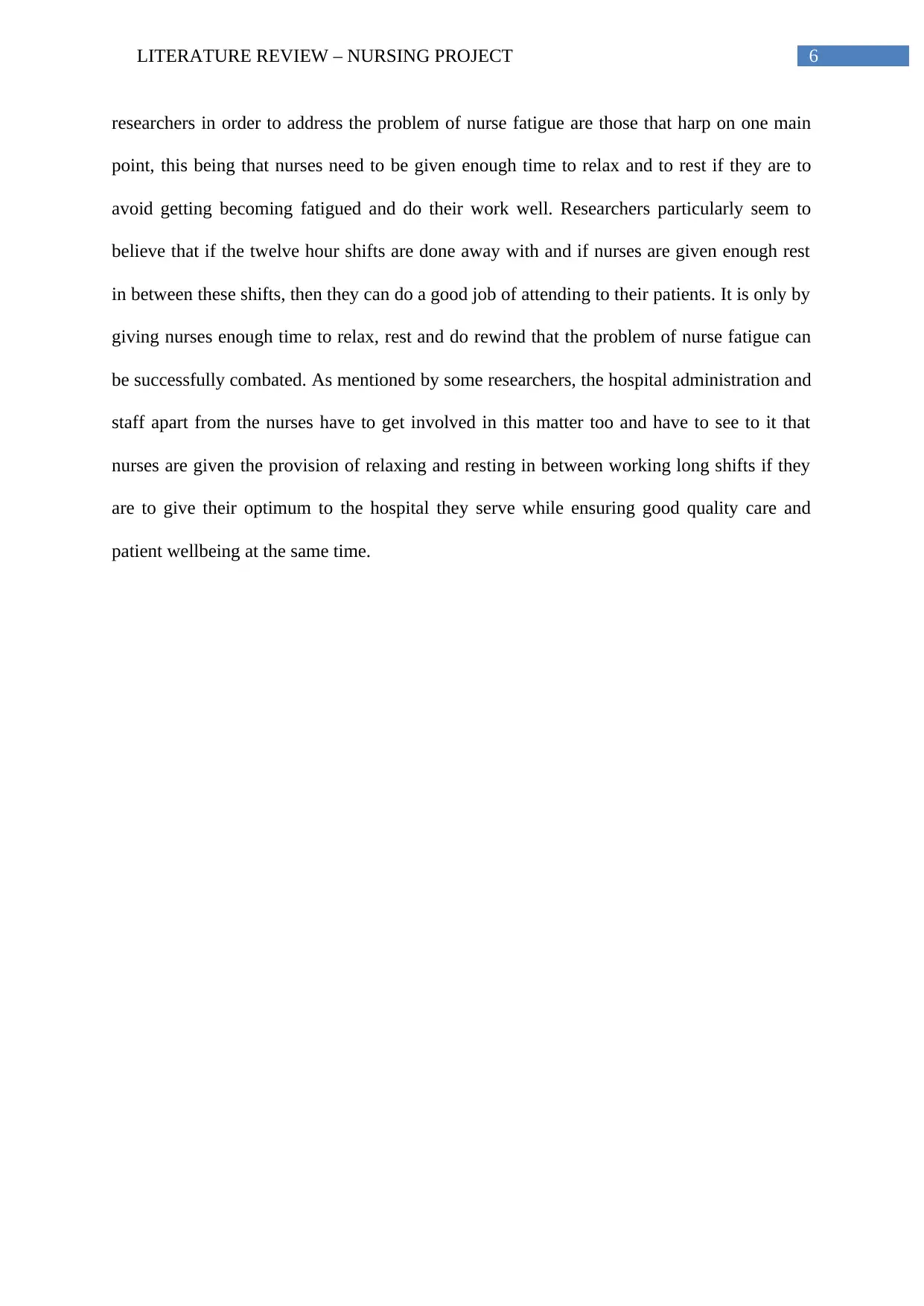
6LITERATURE REVIEW – NURSING PROJECT
researchers in order to address the problem of nurse fatigue are those that harp on one main
point, this being that nurses need to be given enough time to relax and to rest if they are to
avoid getting becoming fatigued and do their work well. Researchers particularly seem to
believe that if the twelve hour shifts are done away with and if nurses are given enough rest
in between these shifts, then they can do a good job of attending to their patients. It is only by
giving nurses enough time to relax, rest and do rewind that the problem of nurse fatigue can
be successfully combated. As mentioned by some researchers, the hospital administration and
staff apart from the nurses have to get involved in this matter too and have to see to it that
nurses are given the provision of relaxing and resting in between working long shifts if they
are to give their optimum to the hospital they serve while ensuring good quality care and
patient wellbeing at the same time.
researchers in order to address the problem of nurse fatigue are those that harp on one main
point, this being that nurses need to be given enough time to relax and to rest if they are to
avoid getting becoming fatigued and do their work well. Researchers particularly seem to
believe that if the twelve hour shifts are done away with and if nurses are given enough rest
in between these shifts, then they can do a good job of attending to their patients. It is only by
giving nurses enough time to relax, rest and do rewind that the problem of nurse fatigue can
be successfully combated. As mentioned by some researchers, the hospital administration and
staff apart from the nurses have to get involved in this matter too and have to see to it that
nurses are given the provision of relaxing and resting in between working long shifts if they
are to give their optimum to the hospital they serve while ensuring good quality care and
patient wellbeing at the same time.
Paraphrase This Document
Need a fresh take? Get an instant paraphrase of this document with our AI Paraphraser
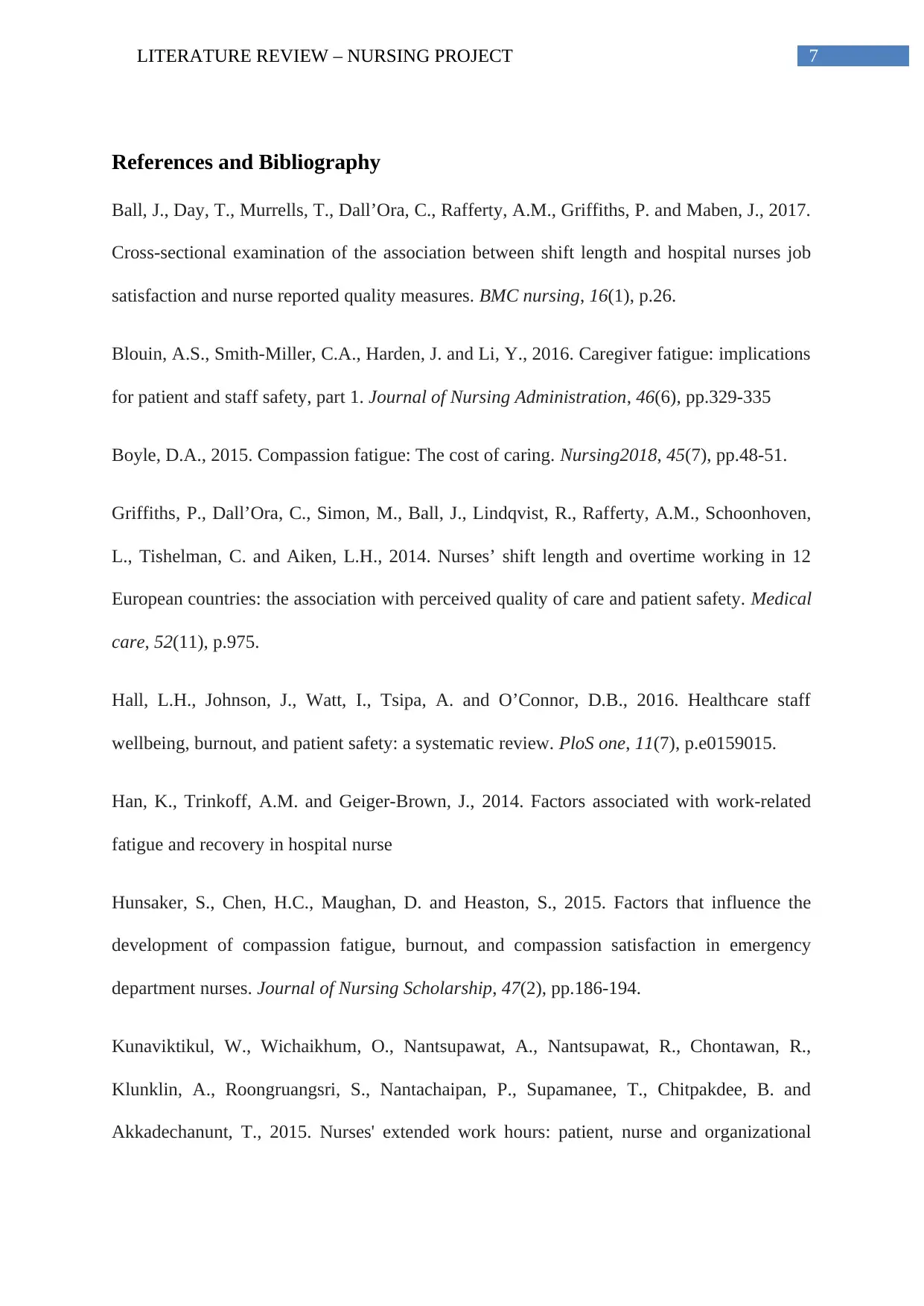
7LITERATURE REVIEW – NURSING PROJECT
References and Bibliography
Ball, J., Day, T., Murrells, T., Dall’Ora, C., Rafferty, A.M., Griffiths, P. and Maben, J., 2017.
Cross-sectional examination of the association between shift length and hospital nurses job
satisfaction and nurse reported quality measures. BMC nursing, 16(1), p.26.
Blouin, A.S., Smith-Miller, C.A., Harden, J. and Li, Y., 2016. Caregiver fatigue: implications
for patient and staff safety, part 1. Journal of Nursing Administration, 46(6), pp.329-335
Boyle, D.A., 2015. Compassion fatigue: The cost of caring. Nursing2018, 45(7), pp.48-51.
Griffiths, P., Dall’Ora, C., Simon, M., Ball, J., Lindqvist, R., Rafferty, A.M., Schoonhoven,
L., Tishelman, C. and Aiken, L.H., 2014. Nurses’ shift length and overtime working in 12
European countries: the association with perceived quality of care and patient safety. Medical
care, 52(11), p.975.
Hall, L.H., Johnson, J., Watt, I., Tsipa, A. and O’Connor, D.B., 2016. Healthcare staff
wellbeing, burnout, and patient safety: a systematic review. PloS one, 11(7), p.e0159015.
Han, K., Trinkoff, A.M. and Geiger-Brown, J., 2014. Factors associated with work-related
fatigue and recovery in hospital nurse
Hunsaker, S., Chen, H.C., Maughan, D. and Heaston, S., 2015. Factors that influence the
development of compassion fatigue, burnout, and compassion satisfaction in emergency
department nurses. Journal of Nursing Scholarship, 47(2), pp.186-194.
Kunaviktikul, W., Wichaikhum, O., Nantsupawat, A., Nantsupawat, R., Chontawan, R.,
Klunklin, A., Roongruangsri, S., Nantachaipan, P., Supamanee, T., Chitpakdee, B. and
Akkadechanunt, T., 2015. Nurses' extended work hours: patient, nurse and organizational
References and Bibliography
Ball, J., Day, T., Murrells, T., Dall’Ora, C., Rafferty, A.M., Griffiths, P. and Maben, J., 2017.
Cross-sectional examination of the association between shift length and hospital nurses job
satisfaction and nurse reported quality measures. BMC nursing, 16(1), p.26.
Blouin, A.S., Smith-Miller, C.A., Harden, J. and Li, Y., 2016. Caregiver fatigue: implications
for patient and staff safety, part 1. Journal of Nursing Administration, 46(6), pp.329-335
Boyle, D.A., 2015. Compassion fatigue: The cost of caring. Nursing2018, 45(7), pp.48-51.
Griffiths, P., Dall’Ora, C., Simon, M., Ball, J., Lindqvist, R., Rafferty, A.M., Schoonhoven,
L., Tishelman, C. and Aiken, L.H., 2014. Nurses’ shift length and overtime working in 12
European countries: the association with perceived quality of care and patient safety. Medical
care, 52(11), p.975.
Hall, L.H., Johnson, J., Watt, I., Tsipa, A. and O’Connor, D.B., 2016. Healthcare staff
wellbeing, burnout, and patient safety: a systematic review. PloS one, 11(7), p.e0159015.
Han, K., Trinkoff, A.M. and Geiger-Brown, J., 2014. Factors associated with work-related
fatigue and recovery in hospital nurse
Hunsaker, S., Chen, H.C., Maughan, D. and Heaston, S., 2015. Factors that influence the
development of compassion fatigue, burnout, and compassion satisfaction in emergency
department nurses. Journal of Nursing Scholarship, 47(2), pp.186-194.
Kunaviktikul, W., Wichaikhum, O., Nantsupawat, A., Nantsupawat, R., Chontawan, R.,
Klunklin, A., Roongruangsri, S., Nantachaipan, P., Supamanee, T., Chitpakdee, B. and
Akkadechanunt, T., 2015. Nurses' extended work hours: patient, nurse and organizational
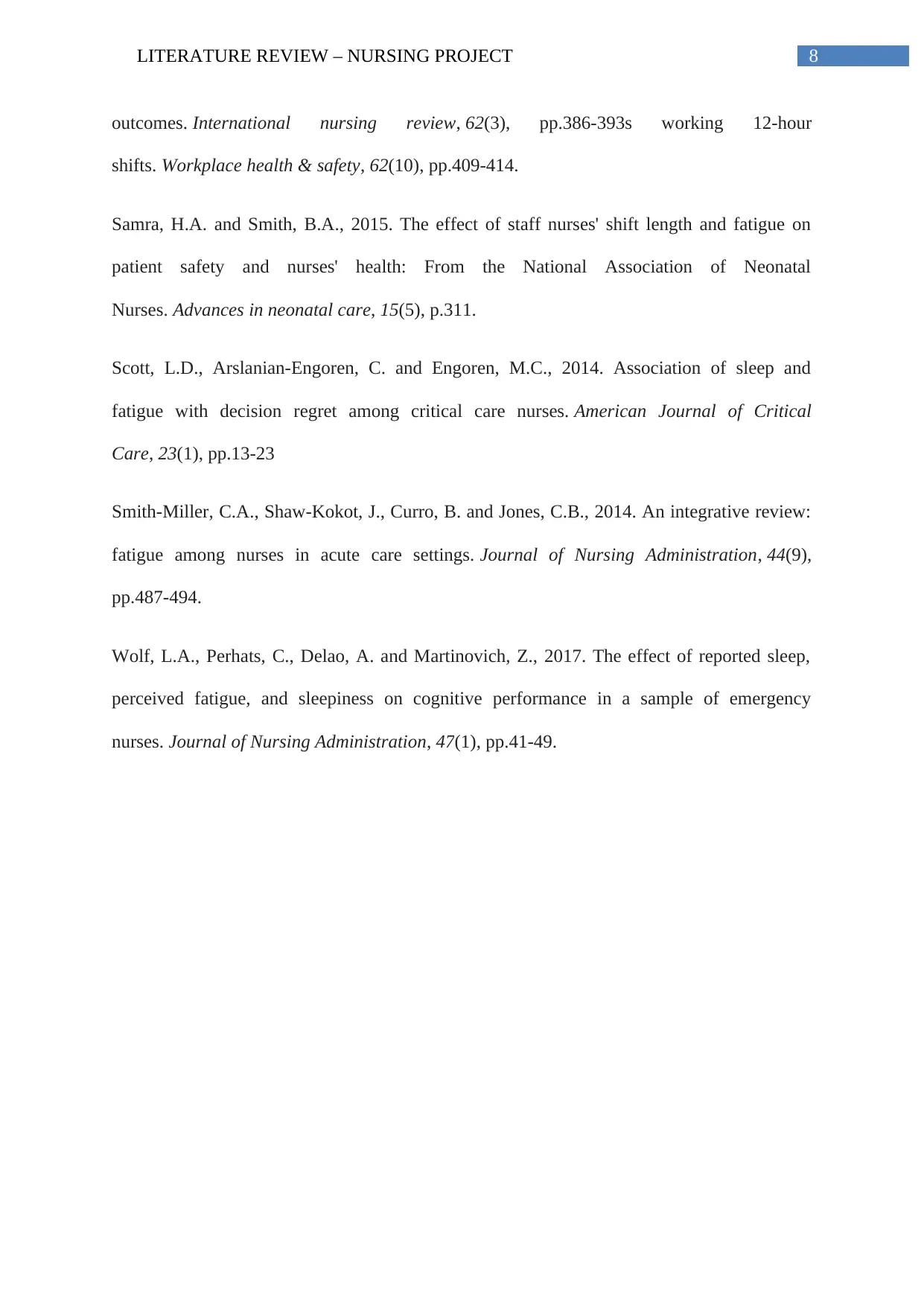
8LITERATURE REVIEW – NURSING PROJECT
outcomes. International nursing review, 62(3), pp.386-393s working 12-hour
shifts. Workplace health & safety, 62(10), pp.409-414.
Samra, H.A. and Smith, B.A., 2015. The effect of staff nurses' shift length and fatigue on
patient safety and nurses' health: From the National Association of Neonatal
Nurses. Advances in neonatal care, 15(5), p.311.
Scott, L.D., Arslanian-Engoren, C. and Engoren, M.C., 2014. Association of sleep and
fatigue with decision regret among critical care nurses. American Journal of Critical
Care, 23(1), pp.13-23
Smith-Miller, C.A., Shaw-Kokot, J., Curro, B. and Jones, C.B., 2014. An integrative review:
fatigue among nurses in acute care settings. Journal of Nursing Administration, 44(9),
pp.487-494.
Wolf, L.A., Perhats, C., Delao, A. and Martinovich, Z., 2017. The effect of reported sleep,
perceived fatigue, and sleepiness on cognitive performance in a sample of emergency
nurses. Journal of Nursing Administration, 47(1), pp.41-49.
outcomes. International nursing review, 62(3), pp.386-393s working 12-hour
shifts. Workplace health & safety, 62(10), pp.409-414.
Samra, H.A. and Smith, B.A., 2015. The effect of staff nurses' shift length and fatigue on
patient safety and nurses' health: From the National Association of Neonatal
Nurses. Advances in neonatal care, 15(5), p.311.
Scott, L.D., Arslanian-Engoren, C. and Engoren, M.C., 2014. Association of sleep and
fatigue with decision regret among critical care nurses. American Journal of Critical
Care, 23(1), pp.13-23
Smith-Miller, C.A., Shaw-Kokot, J., Curro, B. and Jones, C.B., 2014. An integrative review:
fatigue among nurses in acute care settings. Journal of Nursing Administration, 44(9),
pp.487-494.
Wolf, L.A., Perhats, C., Delao, A. and Martinovich, Z., 2017. The effect of reported sleep,
perceived fatigue, and sleepiness on cognitive performance in a sample of emergency
nurses. Journal of Nursing Administration, 47(1), pp.41-49.
1 out of 9
Related Documents
Your All-in-One AI-Powered Toolkit for Academic Success.
+13062052269
info@desklib.com
Available 24*7 on WhatsApp / Email
![[object Object]](/_next/static/media/star-bottom.7253800d.svg)
Unlock your academic potential
© 2024 | Zucol Services PVT LTD | All rights reserved.





